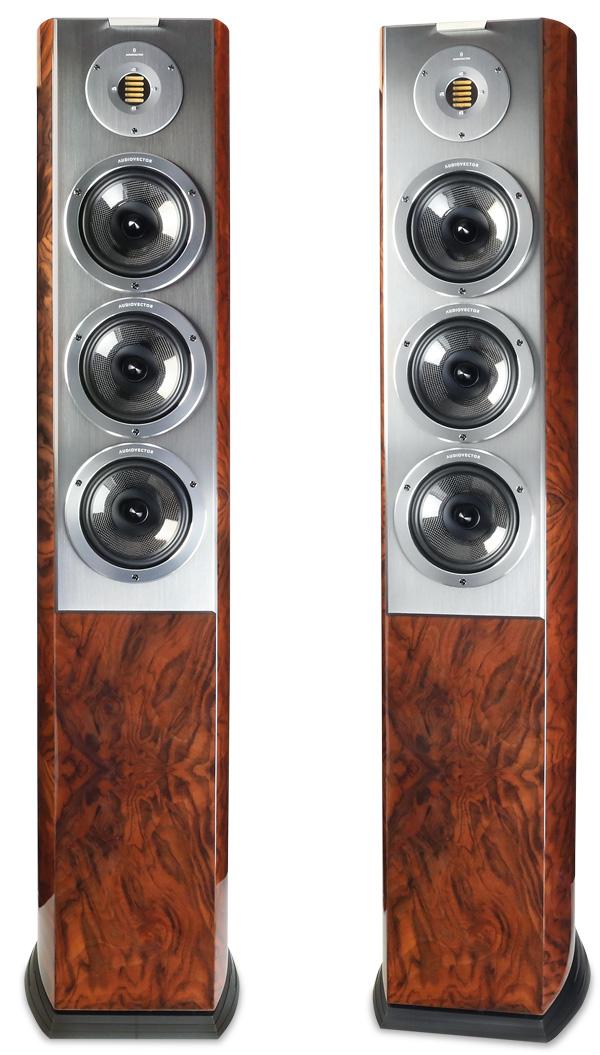Audiovector R 8 Arreté Loudspeaker

 For over 40 years and two generations, this family-run speaker specialist has epitomised the best of Danish design
For over 40 years and two generations, this family-run speaker specialist has epitomised the best of Danish design
Everything about the Audiovector R 8 Arreté is impressive, from the size and scale of the speaker – it stands 144cm tall and weighs over 72kg – to the seemingly fiendish complexity of the design, which appears to have drivers firing and venting in all directions. The piano-lacquered Italian Burl Walnut veneer, seen here, is gorgeous too, and offered alongside Italian Grey, black and white finish options.
But although this floorstander looks and feels like a flagship model from the Danish company, its £53,495 price tag is still a world away from its big brother, the 157cm-tall £190,250 R 11 Arreté. If all that's too rich for you, the entry-point for the Arreté range is the R 1 standmount, at just under £5000, although this and the R 3 and R 6 floorstanders forego the luscious gloss of the R 8 we have here.
Behind The Scenes
Take a walk around the R 8 Arreté, and what initially looks like a relatively conventional, if heroically built, speaker soon reveals itself to be something massively more complex. Yes, the aluminium baffle may appear to house all the drivers – the AMT ribbon tweeter and what are surely a mid/bass driver and a pair of woofers – but that's just the tip of the technology iceberg here. As the venting on the rear panel, also made from aluminium, and the eye-catching finned plinth suggest, there literally is more to this speaker than first meets the eye.
Specifically, Audiovector's top-of-the-baffle AMT tweeter includes an 'integrator grid' to better match its dispersion with the drivers below, while also venting to the rear via a handful of slots in that curved alloy spine. Those three front-firing drivers are actually all mid/bass units, working from around 250Hz-3kHz, their 165mm cones made from carbon and aramid fibre and synthetic resin, to give a light, stiff and well-damped diaphragm. All the drivers here use titanium voice-coil windings.

But there's another mid/bass unit... this is a 100mm driver, firing rearward through more slots in the spine of the speaker, and working with that backwave venting for the tweeter as part of Audiovector's 'Soundstage Enhancement Concept'. Delve deeper and you'll find the company is very fond of its proprietary technologies and 'Concepts'. That venting, for example, is part of what it calls its Low Compression Concept, which involves opening up the cabinet as much as possible to avoid pressure hot spots.
So that's the treble and mid/bass covered, but where's all the really low stuff coming from? The answer is in an isobaric bass configuration, firing downwards and venting both to the rear and through those plinth fins. This uses another of those 165mm drivers, mounted internally, and acoustically-coupled to a further 200mm unit, visible if you ever feel strong enough to turn the speaker over and peer up through the base.
Conceptual Thinking
Other technical aspects of note include NCS (Natural Crystal Structure), which refers to the cryogenic treatment (to –238oC) of all the speaker's copper cabling, so 'the copper molecules realign themselves to their natural positions... reducing resistance'. There's also Audiovector's Freedom Grounding Concept, realised in an extra 4mm cable binding post mounted below the main bi-wire/bi-amp terminals, which acts to eliminate circulating currents in the driver's alloy baskets. Oh, and there's the Individual Upgrade Concept, which provides a path for users to move up to a better model, or take advantage of any improvements made during the lifetime of their product.
While much of this seems very conceptual, the reality is a speaker with an imposing presence in the room, and a real sense of where all the money's gone, in the design, engineering, hand-manufacture and luxurious finish. And it's worth noting that while most sofas and chairs will likely put the listener's ears below the AMT tweeter's axis, the effect when listening proves pretty negligible when moving oneself up and down. So really, wherever you're comfortable, the speakers work very well.
![]() Shining Star
Shining Star
Although Audiovector quotes a 92.5dB sensitivity for the R 8 Arreté, this is a little optimistic. The load is quite tough too, but then it's unlikely that speakers at this level are going to be used with modest integrated amplifiers. For our listening, the R 8 Arreté seemed well-suited to the dose of clean power delivered by the remarkable Constellation Centaur II power amplifier which, with well in excess of 600W/4ohm in tow, had more than sufficient gusto to keep the speakers dancing on their toes!
























































